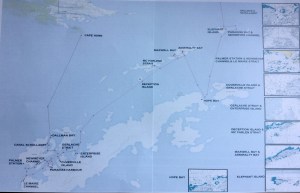 I had expected my fair share of snow capped mountains and stark, white landscape but I was genuinely surprised by its icebergs. I had not imagined them to be so beautiful or abundant. They came in all shapes, sizes, and colors. When it was sunny, they glistened like beautiful gems, and when it was cloudy they took on the color of the sky. I was in total awe of what seemed like enormous man made sculptures of ice and snow – only they were absolutely genuine works of nature.
I had expected my fair share of snow capped mountains and stark, white landscape but I was genuinely surprised by its icebergs. I had not imagined them to be so beautiful or abundant. They came in all shapes, sizes, and colors. When it was sunny, they glistened like beautiful gems, and when it was cloudy they took on the color of the sky. I was in total awe of what seemed like enormous man made sculptures of ice and snow – only they were absolutely genuine works of nature.
The largest icebergs recorded have been calved, or broken off, from the Ross Ice Shelf. We were in the neighborhood, Wow! Tabular icebergs have steep sides and a flat top, much like a plateau, with a length-to-height ratio of more than 5:1. This type of iceberg, also known as an ice island. They are also huge, several stories high with a mass as large as a city block. We passed some larger then our cruise ship. The lecturer said some are bigger than islands (larger than Sicily) now that is big!
Typically, only one-tenth of the volume of an iceberg is above water. The shape of the underwater portion can be difficult to judge by looking at the portion above the surface. We tried to show that in the pictures where there is a little underwater ice showing. The other cool thing I learned/saw was when a piece of iceberg ice melts, it makes a fizzing sound called “Bergie Seltzer”. This sound is made when the water-ice interface reaches compressed air bubbles trapped in the ice. As this happens, each bubble bursts, making a ‘popping’ sound. The bubbles contain air trapped in snow layers very early in the history of the ice.
You may have seen penguins, seals and whales before, but nothing comes close to observing them in their natural habitat. At one point, the naturalist counted 42 whales across the bow of the ship in 15 minutes. We stood there watching the “blows” of whales all around us. David caught one whale tail, I was too mesmerized. The naturalist published a list of the animals we encountered: 6 types of penguins, 5 types of whales, 3 kinds of seals, more birds than than I imagined. Since we were on a cruise ship penguins were always at a distance, but we made up for that with excursions in the Falkland Islands and Puerto Tombo (next post).
Penguins breed in large colonies for the most part, which explains why you may see so many in one place. Most are monogamous for the breeding season and the couple shares the incubation period, with males and females taking turns keeping the eggs warm while the other feeds at sea. The naturalist estimated the colonies we saw to be several hundred thousand breeding pairs, and then their chicks which are fledging this time of year, sends it into the incredible numbers. David took video then zoomed in and it looks like penguin super highways. Click on this link for our video of thousands of penguins running to the sea
Their black and white appearance protects them from predators. Looking upward, for example, orcas and leopard seals have difficulty distinguishing the white penguin bellies from the water’s surface while the penguin’s dark back camouflages it from above. Our best treat was to find penguins on icebergs. You had to be quick though, if the ship got too close they would jump back into the water, I mean wouldn’t you!
The cruise was a fantastic experience it exceeded every expectation. My only mistake was putting Antarctica last on my list of the seven continents to visit. Take my advice – make it the next one on your travels.




















